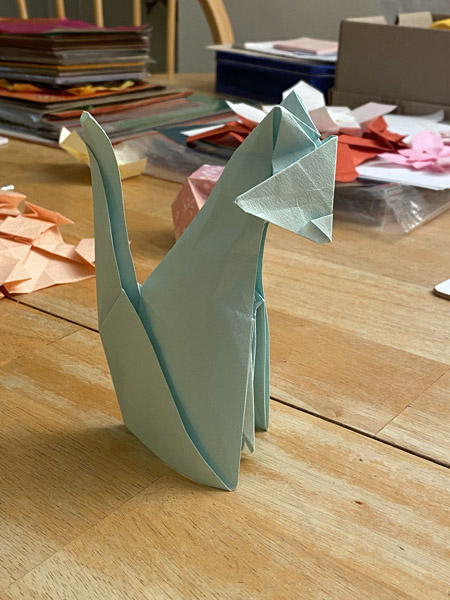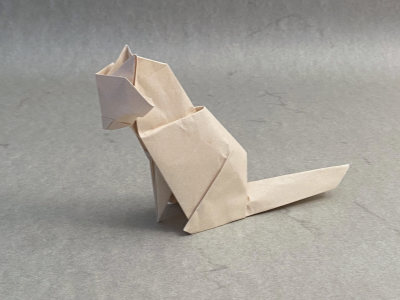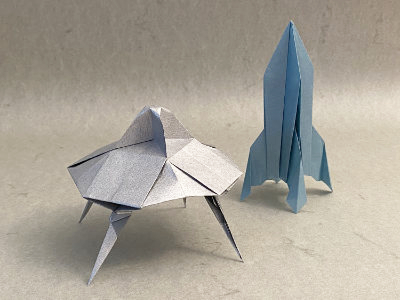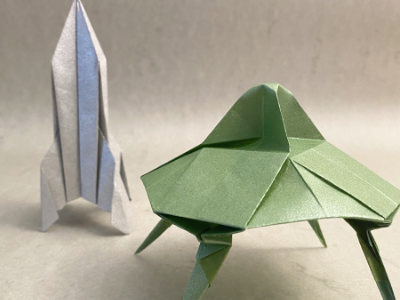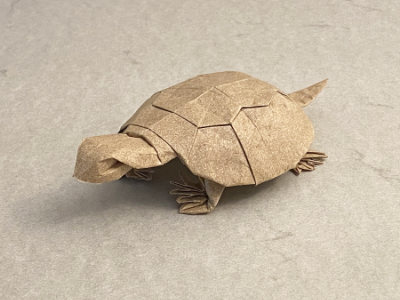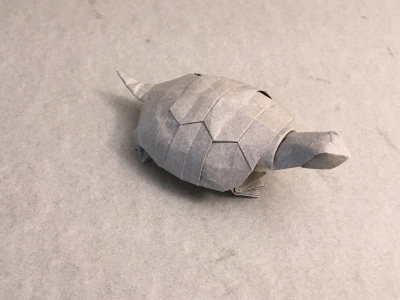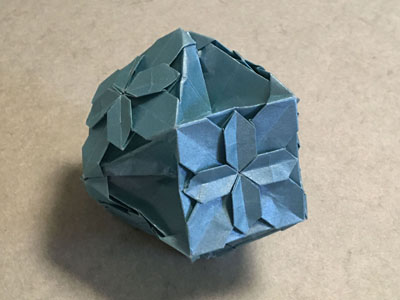This was the first in-person origami convention in three years, at the Sheraton in midtown Manhattan. It was great to be back, to see all my origami friends and catch up on what everyone was up to.
There was an exhibit, which was a big motivator for me to get off my butt and start folding some new things. I had four new models, plus a good handful of my best prior work. One of the new models is the Space Cat, named after my new jazz and funk band. It’s variation on Sophie the Cat, sculpted in a streamlined midcentury modern style out an appropriate shade of blue paper.
The others were more ambitious: single-sheet polyhedra with tessellation or other surface textures. One was my Hydrangea Cuboctahedron, which I actually folded last year but never had a chance to exhibit before, folded out of a sheet of blue 19″ shiny paper, which has a sparkle similar to Stardream but is thinner and crisper.
The other two were variations on a dodecahedron, with various regions sunk to bring out five-pointed stars latent in the geometry of the design. One had the embedded star oriented to that its corners align with the corners of the base dodecahedron’s pentagonal faces. The other and the corners of the stars at the midpoints of the edges of the pentagons.
These took quite alot of effort to make. First the design had to be worked out with drawings, then single-hemisphere studies. Then the pre-creasing took several evenings per model, very technical and precise, using fivefold symmetry. Each is folded out of a pentagon, and creating a regular pentagon from a square is a non-trivial task in itself. I used 15″ Tant paper for these, and the model is about at the limit of what the paper could handle without getting too soft.
Up until the very end, I wasn’t even sure if they were going to work, if I’d be able to finish and close the model. The layout was such that one pentagon of dodecahedron was in the center of the paper, and on the opposite face the five corners come together to form a lock. I’ve used this technique successfully on other models including my Stellated Dodecahedron and my Great Dodecahedron. It’s the nature of single-sheet polyhedra, being folded from a flat sheet, that you have a lot of layers of paper at the end, and they need to be tucked away so that the tendency to spring open is countered, or at least minimized, while maintaining the pattern on the exterior surface. However for these two new ones, this approach created a pinwheel out of the corners on the last face, so I ended up tucking the paper inside instead. This left a pentagonal hole at the bottom (which no one could see) but allowed me to reach inside to do the final shaping, which was pretty fragile and tricky.
I’ve been doing single-sheet polyhedra for years, but sometimes I feel like people don’t really get them, because most people make models like this as modulars, fitting together many small sheets, which is much easier to do. But my new models brought out the surface in a way that could not be done with modulars, and finally people took notice. It’s particularly gratifying when folders I admire are impressed with my work. Boice Wong, who specializes in supercomplex human figures such as Samurai and videogame heroes, affectionately called them “fake modulars” and told me they were causing quite a buzz. Indeed, I got quite a few compliments on my exhibit and got into several conversations with other folders about the designs.
So, having gotten these models to work at all, I now want to fold really nice ones out of my last remaining sheet of ivory Marble Winstone paper, which I can cut to yield two 19″ pentagons. I figure if I’m going to do this, I might as well see if I can come up with a layout that lets me close the bottom nicely. So I spent a good part of my free folding time at the convention exploring various layouts for the dodecahedron. Of course John Montroll was around, and it was lots of fun to jam on pentagons and polyhedra with him.
This led me on a quest to find a source for large, accurately pre-cut pentagons in high-quality paper, but alas no such thing exists. I befriended Kathy, the lady who usually makes such things – octagons, hexagons, etc. – and sells them to the origami source. She says she has a jig for it and can custom cut some for me. I also bid on and won a silent auction item which was a nice wooden storage box filled with various papers, included a drawer full of 10″ pentagonal sheets.
As I mentioned, this was the first in-person convention in several years due to the pandemic, and it was at the Sheraton Hotel in New York city, a new venue for us. Overall it worked out quite well, with nice conference rooms for the classes and hospitality. Origami USA negotiated a really good rate for the hotel rooms. Since getting in and out the city can be a pain, Jeannie and decided to stay the night Friday and Saturday, and this also worked out quite well.
This year the convention went to a system where people sign up to take classes ahead of time on the web site, so I ended up taking alot more classes than usual. Mostly I took classes from friends of mine who are complex folders to see if I can glean some insight to their design process as well as different teaching styles. I took Brain Chan’s Cicada, inspired by the classic model but with added legs; Beth Johnson’s Circus Elephant, and an airplane by Michael LaFosse.
I taught two classes. Saturday it was Sophie the Cat. This is a high-intermediate level model and the class was full. I didn’t have a document camera in my room, so there was a fair amount of going around and showing some of the steps up close. But everyone got thru successfully. On Sunday I taught my Five-Banded Armadillo. This is a complex model and it took up two periods. Again, the class was full. This was a bit surpassing for a complex model; sometimes I only get a few students on classes like these. A document camera would have helped here as well, but still everyone folded it successfully and had a good time.
I saw alot of first-timers, some of whom were teaching and exhibiting. This is a very good sign for future conventions. Over the course of the weekend quite a few people came up to me asking me to sign their copy of my Animal Sculptures book, or to take a picture with me, or just to tell me they really admire my work. This happens a bit at every convention, but never before to this degree. Very flattering. Or maybe I’ve just forgotten since it’s been a long time.
Saturday night was a screening of a documentary film about the the artist Kevin Box, who create large metal sculptures of origami figures, and collaborates with Beth, Michael and Robert Lang on the designs. Really fascinating.
Michelle came into the city with us Friday and stayed with us overnight. She had to work Sunday – she chose to come to convention on the day with more dragons and flowers – so she drove home Saturday evening, and came back again Sunday evening. This was her first time driving in Manhattan, but she learned to drive in The Bronx, so was pretty unfazed.
Sunday night was the giant folding contest, which was alot of fun. Marc Kirschenbaum was the emcee, and I was asked to be a judge along with Beth, Michael, Richard Alexander, and Quentin Trollop. Of course every team gets a prize, so the challenge is to think of a fun category appropriate to each model. For example, the Blue Whale won the “deepest fold” and the Giraffe, believe or not, lost out to the Emperor Penguin in the “tallest” category, but won “best legs”.
Sunday night we all went home to sleep, and came back Monday in time for the start of the afternoon session. I haven’t spent much time in the city in the last three years, just the occasion meeting or concert, cuz I’ve been working from home since the start of the pandemic. The first day I was there New York felt really strange and alien to me – crowded, noisy, chaotic, rectangular, and I was noticing lots of things in a sort of heightened way. The second day I could feel myself tuning into the wavelength to appreciate everything on its own terms, and by the third day it was as if I’d never been away.
Monday I took Boice’s class on action figures. I’ve been experimenting with human figures and was looking to improve at it. He first presented a nice box-pleated human figure model. It uses a 16 x 16 grid, but it otherwise very similar to my Astronaut, which uses an 8 x 8 grid, and my subsequently developed Robot Base, which uses a 12 x 12 grid (the Robot remains unfinished, hence the base). It’s a good go-to human figure base. Then we spent most of the class working on stances and poses to make the figure more lifelike natural. Harkened back to figure drawing classes in art school. I made a figure standing on one foot as if to delver a karate kick, and another mediating in a lotus position. Picked up alot of good insight.
A fun topper to the whole weekend: As we were getting our car out of the garage at the end of the night, there was a guy in line ahead of us in a Frank Zappa T-shirt, and I recognized him as Ed Palermo, leader of a big band that does arrangements of Zappa and other prog rock artists. He does a monthly gig at the Iridium right around the corner, and had just come off the bandstand. So we struck up a conversation and I gave him links to some of my music to listen too. Asked him to keep me in mind if he every needs a sub on sax.
Next up: photos
